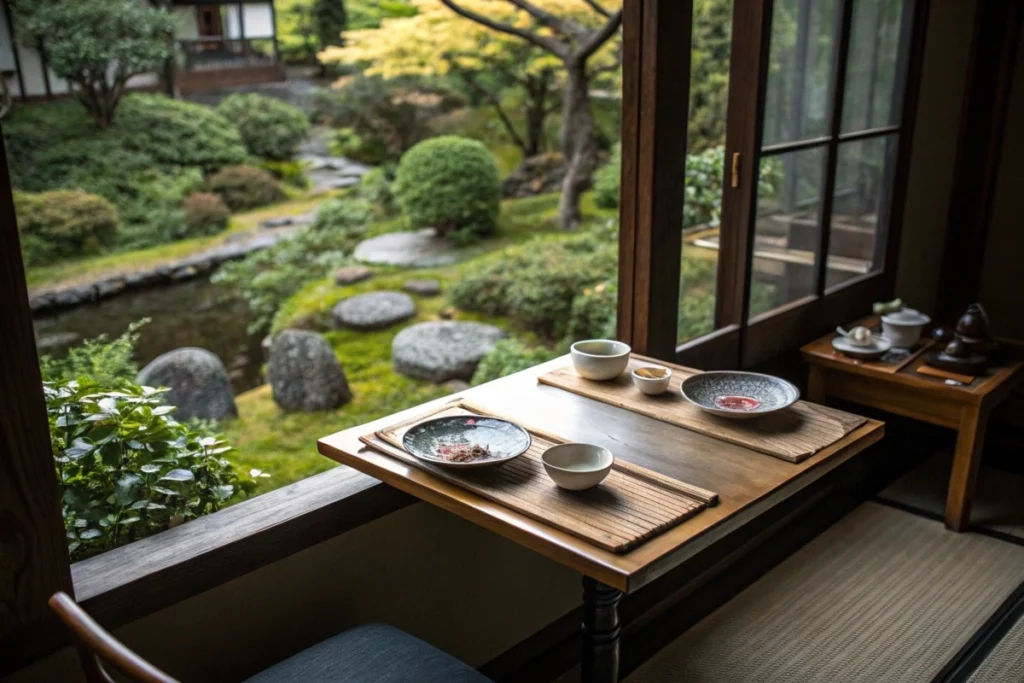Few dishes in global cuisine are as recognizable and beloved as sushi. From high-end omakase bars in Tokyo to conveyor belt sushi shops in London, this emblematic dish embodies japanese food sushi history at every bite. Yet, many sushi enthusiasts remain unaware of its fascinating backstory—how it evolved from a preservation technique into a worldwide culinary phenomenon. Sushi’s journey reveals much about Japan’s resourceful spirit, its delicate balance between tradition and innovation, and its enduring cultural impact.
In this comprehensive 3,000-word guide, we’ll trace sushi’s centuries-long history, exploring its beginnings, transformations, and ultimate rise to global prominence. Along the way, you’ll uncover how sushi origin country debates occasionally spark curiosity—some wonder, is sushi Chinese? We’ll clarify such misconceptions while illuminating the art, symbolism, and modern adaptions that keep sushi relevant in today’s fast-paced gastronomic landscape.
If you’re curious about Japanese culinary depth, take a look at traditional-japanese-desserts-recipe to explore sweet treats that complement sushi’s savory profile. Now, let’s embark on a deep dive into japanese food sushi history, unveiling the intricate tapestry behind one of Japan’s most cherished dishes.
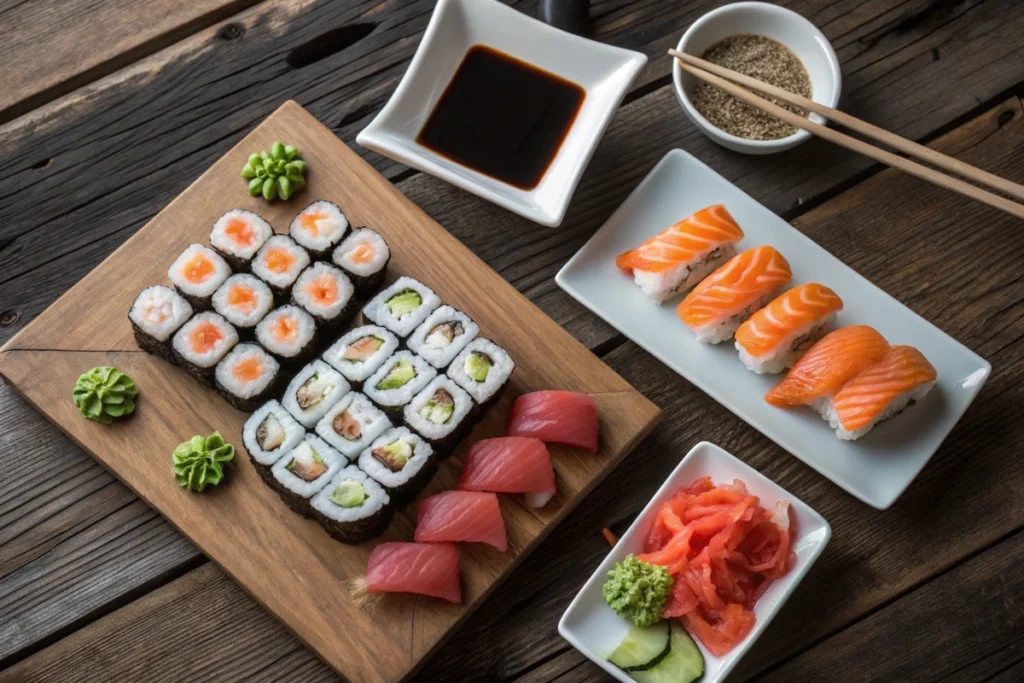
Sushi’s Unique Essence
The Multi-Faceted Appeal of Sushi
Sushi stands at the intersection of history, art, and practical culinary science. On the surface, sushi’s appeal lies in its fresh fish slices and balanced seasonings—like vinegared rice and a hint of wasabi. Yet, digging deeper reveals a dish that has symbolized Japan’s adaptability and devotion to quality for centuries. This fusion of flavor and craft has propelled sushi into an international favorite, fueling japanese food sushi history with continuous evolution.
- Health Benefits: Sushi often features lean protein, omega-3–rich fish, and moderate carbohydrates, making it a go-to choice for health-conscious diners.
- Visual Aesthetics: Chefs treat each sushi piece like an edible canvas, blending color and texture for maximum appeal.
- Cultural Symbolism: In Japan, sushi represents hospitality, craftsmanship, and respect for fresh ingredients.
Linking Sushi to Broader Japanese Food Culture
Beyond its status as a standalone dish, sushi embodies core elements of Japanese cuisine—washoku, recognized by UNESCO for balance and respect for nature. When you savor sushi, you experience more than just fish on rice. You embrace a tradition that values seasonality, minimal waste, and artful presentation. This synergy resonates across the country’s culinary tapestry, from ramen bowls to tempura counters. For a taste of Japan’s flair in other domains, see how steak-japanese-recipe approaches grilled meats with similar precision.
Sushi’s Relationship to Seafood
The broad question who invented sushi sometimes triggers a side debate: Did early sushi forms come from Southeast Asia? China? Japanese records affirm a local lineage, yet the interplay of cross-cultural influences shapes sushi’s story. Regardless of precise origins, the dish thrives due to Japan’s island geography, abundant in fish varieties—tuna, salmon, sea bream—providing year-round supply for fresh, high-quality seafood.
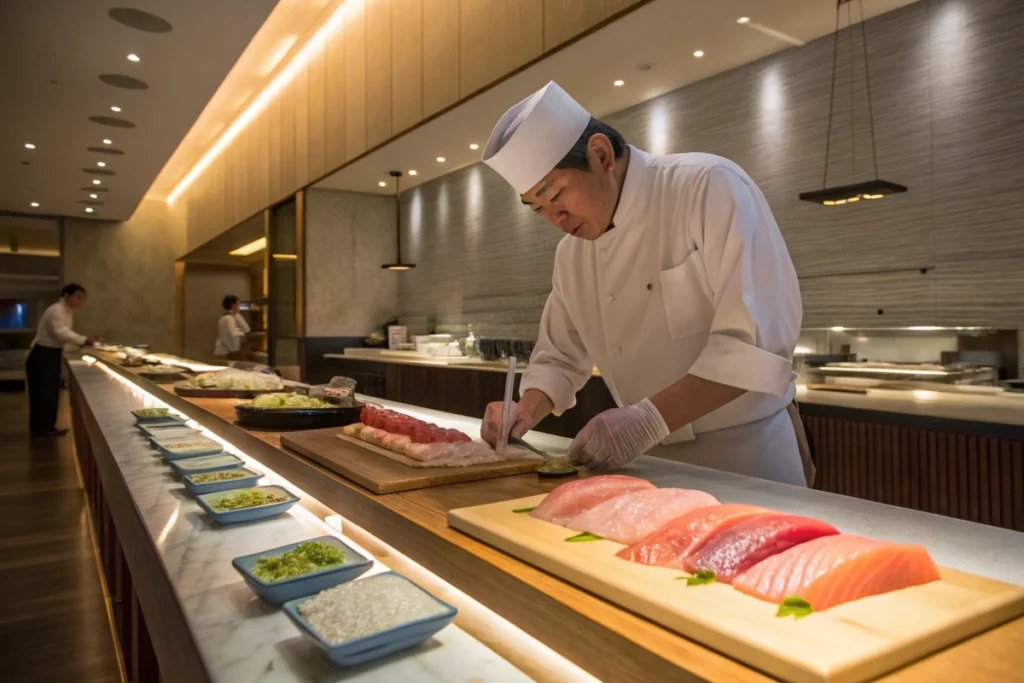
Early Conceptions of Sushi
The Origins: Fermented Fish and Rice
The earliest references to something resembling sushi point toward a preservation method involving salted fish and fermented rice. Known historically as narezushi, it allowed fish to remain edible for extended periods by using fermentation. This technique is critical in understanding japanese food sushi history, as it underscores the practicality that once defined the dish. Modern sushi is far removed from that pungent fermentation, but the principle of harnessing rice’s preserving power remains foundational.
- Narezushi: Fish layered in salted, fermented rice for months. After fermentation, the rice was typically discarded, and only the fish was consumed.
- Regional Variations: Different regions employed variations of this method. Some used vinegar or spiced rice to enhance flavor. Others introduced unique fish, from freshwater carp to ocean-caught species.
- Southeast Asian Influence: Some historians propose that early sushi techniques traveled from or through parts of Southeast Asia and China, blending with Japanese methods to create a distinct local form.
Evolution to Vinegared Rice
Over time, Japan’s approach to narezushi changed. By the Edo period (17th–19th century), fermented rice was gradually replaced with vinegared rice, speeding up the preparation process and moderating the strong flavors. This shift formed the backbone of what we recognize as sushi today—fresh fish combined with lightly seasoned rice. The development of hayazushi (fast sushi) also dramatically shortened fermentation times.
Sushi’s Move to Edo (Tokyo)
Edo (now Tokyo) played a critical role in shaping sushi’s future. Known for a bustling population and abundant seafood, Edo developed a distinct style—edomae sushi. Skilled chefs formed small, bite-sized pieces of vinegared rice topped with fish or other ingredients. Eaten on the go, edomae sushi matched the city’s fast-paced lifestyle, bridging convenience and quality. This era also cemented the artisan chef tradition—leading to rigorous training and specialization that continues to define sushi craft.
- Artisan Culture: Chefs were revered for their knife skills and deep knowledge of ingredients, forging an almost master-apprentice relationship in sushi shops.
- Street Food Beginnings: Edomae sushi started as street fare, sold at portable stalls. Over time, dedicated sushi restaurants emerged, formalizing the experience.
Comparing with Chinese Origins
Some might argue is sushi Chinese, given China’s historical influence on Asia. While it’s true that early fermentation methods likely arrived via continental connections, Japan made the concept uniquely its own. Over centuries, the dish morphed in Japan, adopting local fish species, vinegared rice, and careful presentation—hallmarks distinct from any direct Chinese culinary practice. By the modern era, sushi’s identity firmly planted roots in Japan, fueling pride and culinary tourism.
Understanding these early conceptions of sushi clarifies how a simple preservation method grew into an elegant staple of Japanese cuisine. If you’re curious about other dishes shaped by historical contexts, see how a japanese-curry-recipe-one-piece merges classic Japanese curry with contemporary pop culture flair.

Practical Examples: Sushi in Modern Settings
Sushi in Everyday Life
While japanese food sushi history suggests a once-luxurious dish, modern sushi manifests in everyday routines. City dwellers in Japan might grab kaiten-zushi (conveyor belt sushi) for quick lunches, or pick up nigiri sets at convenience stores. Office workers rely on these accessible meals as healthy, portion-controlled lunch solutions, bridging practicality and gastronomic satisfaction.
- Conveyor Belt Shops: Affordable and efficient, these restaurants line up sushi plates on rotating belts. Diners simply pick plates they fancy, paying by the color-coded or QR-coded plate type.
- Take-Out Sushi: Grocery stores and conbini (convenience stores) offer packaged sushi sets, featuring crowd favorites like salmon or tamago (egg).
- Sushi for Celebrations: In Japan, families often order special sushi platters for parties or special occasions, reflecting sushi’s cultural role as a symbol of hospitality.
Global Fusion and Adaptations
Outside Japan, sushi’s adaptability gave birth to dishes like the “California roll,” “Philadelphia roll,” or even sushi burritos. These examples show how sushi “marries” local tastes worldwide, from using avocado or cream cheese in the U.S. to featuring local fish varieties in Europe. The question when was sushi invented might date back centuries, but its modern reinventions show no sign of slowing. By exploring japanese-chicken-fried-rice-recipe- or other fusion items, you can spot parallels in how staple Japanese dishes adapt to global tastes.
Sushi in High-End Dining
At the opposite end of the spectrum, sushi also thrives in haute cuisine contexts. Michelin-starred sushi bars demand reservations weeks in advance, offering omakase—a chef-driven experience where the selection evolves based on seasonality and the chef’s inspiration. Diners pay a premium for meticulously curated fish cuts, precise hand-formed rice, and the chef’s intimate guidance.
- Omakase Culture: The chef decides each course, from lighter whitefish to bolder tuna or uni. This curated progression ensures optimal flavor arcs.
- Artistry vs. Efficiency: While conveyor belt sushi maximizes efficiency, omakase highlights artisan skill, dedicated service, and in-depth ingredient knowledge.
- Global Recognition: Renowned sushi chefs sometimes open branches in major cities like New York or London, spreading the edomae style worldwide.
Sushi for Health and Wellness
In the West, sushi often appeals to those seeking lighter, fresh meals. Rolls featuring vegetables, lean fish, or minimal sauce fit well into a balanced diet. Though fusion rolls can be calorie-dense (cream cheese, mayonnaise), choosing simpler options—like salmon nigiri—supports healthy living without sacrificing flavor. This synergy of taste, convenience, and perceived wellness fosters the unstoppable popularity of japanese food globally.
Expanding the Sushi Concept
Sushi’s popularity doesn’t limit it to fish and rice. Vegetarians can enjoy versions made with cucumber, avocado, or pickled radish. Recently, vegan sushi with plant-based “tuna” or egg alternatives also gained traction, reflecting an inclusive shift in modern cuisine. Techniques from sushi also inspire other foods: rice balls shaped like sushi, desserts mimicking sushi appearances, or creative roll-style sweets. For instance, cross-referencing japanese-sweets-recipes can spark ideas for dessert rolls that mimic sushi shapes, bridging sweet flavors with sushi aesthetics.
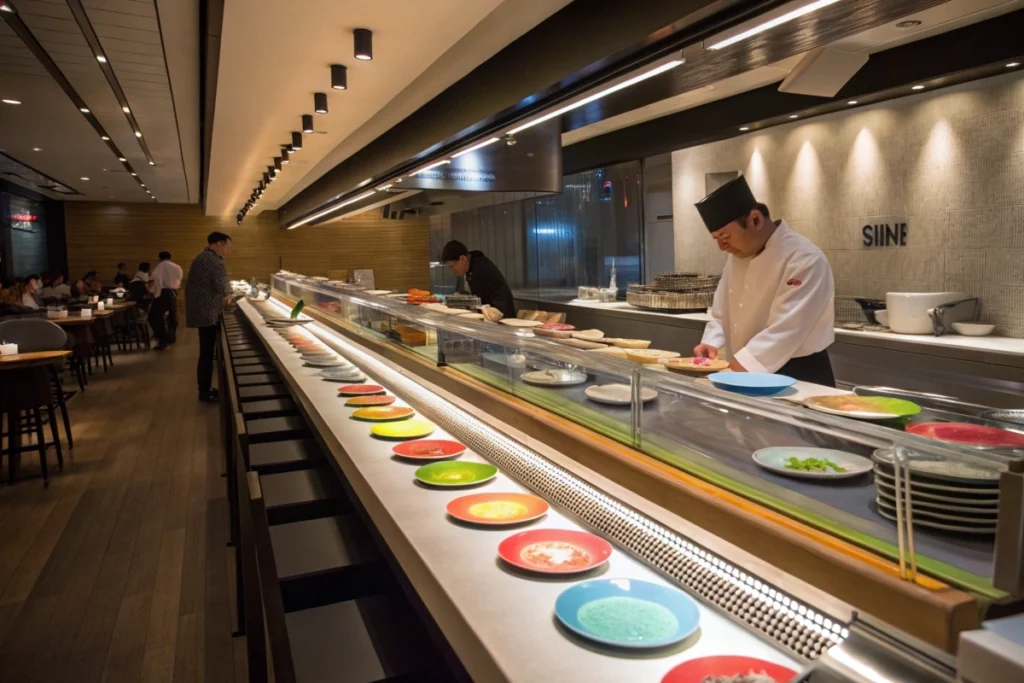
FAQs About Japanese Food Sushi History
1. What is the origin of Japanese sushi?
The question what is the origin of Japanese sushi traces back to ancient preservation methods involving salted fish and fermented rice (narezushi). Over centuries, Japan refined this into vinegared rice and fresh fish, culminating in the sushi we recognize today. Early references suggest influences from Southeast Asia, but Japan’s unique adaptation shaped modern sushi’s identity.
2. Why is sushi so important to Japanese culture?
Sushi holds cultural significance as a reflection of minimalism, seasonality, and respect for high-quality ingredients. Historically, it also symbolized Japan’s ingenuity in food preservation and resourcefulness in using local seafood. Today, sushi remains integral to celebrations, representing hospitality and meticulous craftsmanship.
3. What does the sushi symbolize?
Sushi symbolizes harmony between humans and nature, bridging fresh fish and cultivated rice. It also conveys artistry through aesthetic plating and precise technique. For many Japanese families, sushi is a celebratory dish, embodying communal bonding and tradition.
4. What are 5 facts about sushi?
- Ancient Preservation: Early sushi was a fermentation method, discarding the rice after preserving the fish.
- Edomae Influence: Tokyo’s Edo period introduced quick, vinegared forms, forming modern sushi.
- Varied Types: Nigiri, maki, temaki, and sashimi all fall under “sushi culture,” differing in preparation and presentation.
- Health Factor: Fresh fish, minimal oils, and balanced portion sizes lend sushi a health-conscious edge.
- Global Adaptations: Popular rolls like the “California roll” exemplify how sushi fuses with local tastes around the world.
5. Is sushi from China or Japan?
While early forms of fermented fish-and-rice might have originated from regions in Asia, including parts of China or Southeast Asia, modern sushi’s identity is firmly rooted in Japan. Through centuries of local innovation, Japan cultivated the vinegared rice approach and refined fish selection, making sushi distinctly Japanese.
6. When was sushi invented?
The earliest records date back over a thousand years, referencing fermentation processes akin to narezushi. However, recognizable vinegared-rice sushi emerged around the 17th century in Japan’s Edo period, evolving rapidly into the 19th century.
7. Who invented sushi in its modern form?
Though no single person “invented” modern sushi, Hanaya Yohei is often credited with popularizing the fast-paced edomae nigiri style in the 19th century. His approach offered quick, tasty morsels of fresh fish and rice to bustling Edo residents, laying the groundwork for contemporary sushi bars.
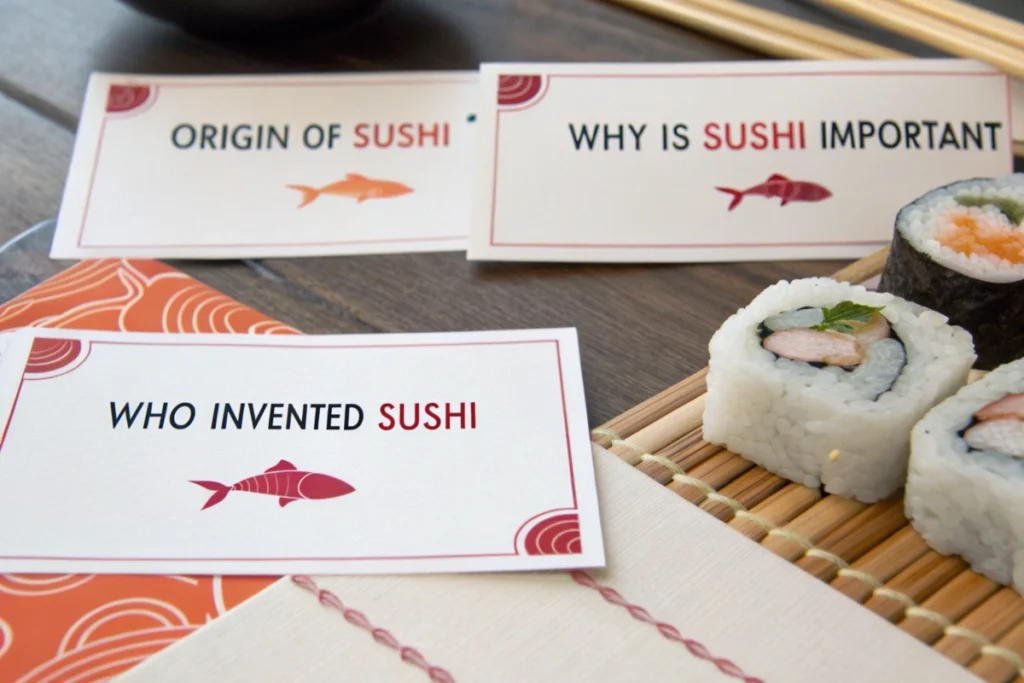
Conclusion
Japanese food sushi history reveals a story that goes well beyond raw fish and vinegared rice. Sushi began as a practical preservation technique before evolving into an artisan dish symbolic of Japan’s resourcefulness, culinary precision, and respect for natural bounty. This remarkable trajectory—from narezushi in ancient times to the thriving conveyor belt and omakase cultures today—illustrates how a dish can remain faithful to tradition while adapting to modern, global tastes.
Ultimately, sushi’s universal appeal stems from its unique ability to balance simplicity and sophistication. Whether you pick up a quick kaiten-zushi lunch or invest in a luxurious omakase dinner, sushi offers a compelling blend of fresh flavors, umami depth, and aesthetic elegance. That synergy cements its place as a cornerstone of Japanese cuisine and a defining element of global culinary culture.
For those interested in exploring more Japanese culinary gems, check out our easy-japanese-recipes for straightforward yet authentic dishes you can try at home. As sushi’s story continues to unfold worldwide, it reinforces the notion that food serves as a powerful cultural ambassador—opening hearts, bridging traditions, and crafting delicious shared experiences.
